The Non Lethal Projectiles Market is estimated to be valued at USD 1.4 billion in 2025 and is projected to reach USD 2.4 billion by 2035, registering a compound annual growth rate (CAGR) of 5.4% over the forecast period.
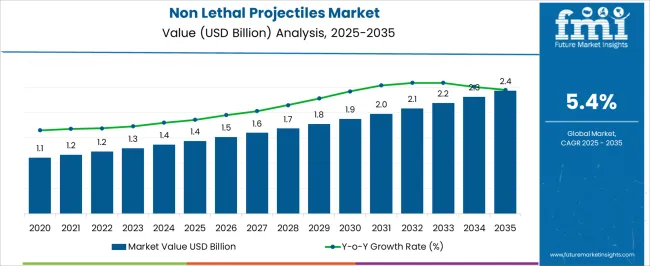
| Metric | Value |
|---|---|
| Non Lethal Projectiles Market Estimated Value in (2025 E) | USD 1.4 billion |
| Non Lethal Projectiles Market Forecast Value in (2035 F) | USD 2.4 billion |
| Forecast CAGR (2025 to 2035) | 5.4% |
The Non Lethal Projectiles market is experiencing steady growth due to the increasing focus on public safety, crowd control, and law enforcement operations worldwide. The current market scenario reflects rising demand from both developed and emerging regions, where authorities are prioritizing solutions that minimize fatalities while maintaining effective security measures. Technological advancements in projectile design, material composition, and kinetic control have enhanced the efficiency, accuracy, and safety of non lethal projectiles, making them more widely acceptable for policing and security purposes.
Regulatory frameworks in many countries have encouraged the adoption of less-lethal alternatives over traditional firearms in civil control scenarios. Additionally, growing urbanization and frequent public gatherings have elevated the need for controlled intervention tools.
As investments in public safety infrastructure increase and awareness of humane law enforcement practices spreads, the Non Lethal Projectiles market is expected to sustain its growth trajectory, offering opportunities for innovations in materials, delivery mechanisms, and integrated enforcement systems Future growth will likely be shaped by improvements in projectile impact performance, officer safety, and enhanced operational versatility.
The non lethal projectiles market is segmented by product type, impact type, end user, and geographic regions. By product type, non lethal projectiles market is divided into Rubber, Bean Bag Rounds, Bullets, Plastic, Wooden, Pellets, Sponge Grenades, Gas & Spray Rounds, and Electroshock Weapons. In terms of impact type, non lethal projectiles market is classified into Kinetic And Physical, Chemical, and Electromagnetic. Based on end user, non lethal projectiles market is segmented into Police And Law Enforcement, Civilians, and Military. Regionally, the non lethal projectiles industry is classified into North America, Latin America, Western Europe, Eastern Europe, Balkan & Baltic Countries, Russia & Belarus, Central Asia, East Asia, South Asia & Pacific, and the Middle East & Africa.
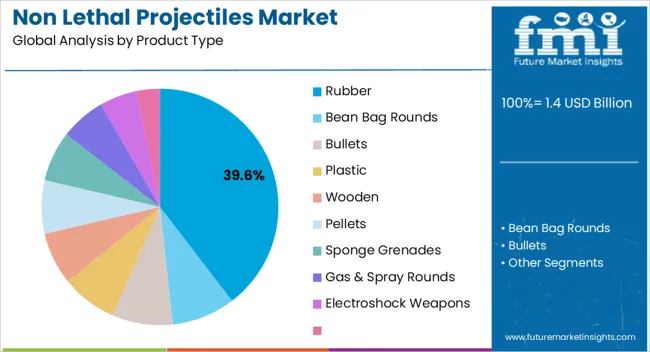
The rubber product type is projected to account for 39.60% of the Non Lethal Projectiles market revenue in 2025, making it the leading material segment. This dominance is being driven by the material’s inherent flexibility, durability, and ability to deliver controlled impact with minimal risk of severe injury. Rubber projectiles are widely used in situations that require crowd control, non-lethal compliance, and public safety enforcement.
Their performance characteristics, including energy absorption and predictable ricochet behavior, allow authorities to apply them in diverse operational scenarios with confidence. Growth has been reinforced by the cost-effectiveness of rubber projectiles compared with other materials, alongside the ease of mass production and consistent quality.
Furthermore, the material’s compatibility with a variety of deployment mechanisms and its acceptability under law enforcement regulations have strengthened its market position The trend toward humane, risk-mitigated security solutions continues to favor rubber projectiles, ensuring that this segment maintains its leading share in the market.
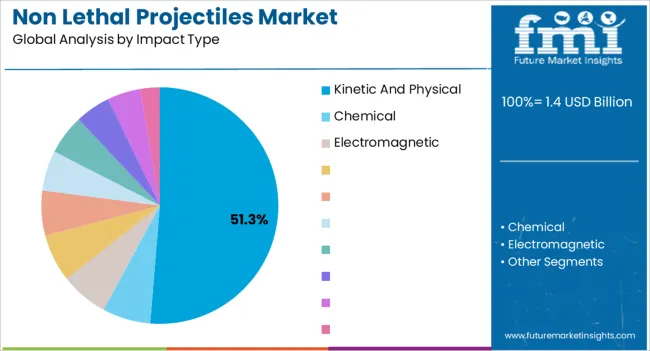
The kinetic and physical impact type is anticipated to hold 51.30% of total Non Lethal Projectiles market revenue in 2025, establishing it as the dominant impact category. This segment’s leadership is being attributed to its ability to deliver immediate compliance through controlled force, while minimizing fatalities and long-term injuries. Kinetic projectiles are effective in dispersing crowds, subduing suspects, and managing high-tension scenarios without escalating violence.
Their growing adoption has been reinforced by law enforcement agencies’ preference for impact-based solutions that offer predictable operational outcomes and easy integration into standard policing protocols. As public safety concerns rise and demand for humane intervention tools increases, the segment benefits from its proven reliability and versatile use cases.
The capacity to combine software-assisted targeting, impact control, and operator training has further enhanced adoption This segment is expected to maintain its market leadership as authorities continue to seek balance between operational effectiveness and minimizing harm during enforcement operations.
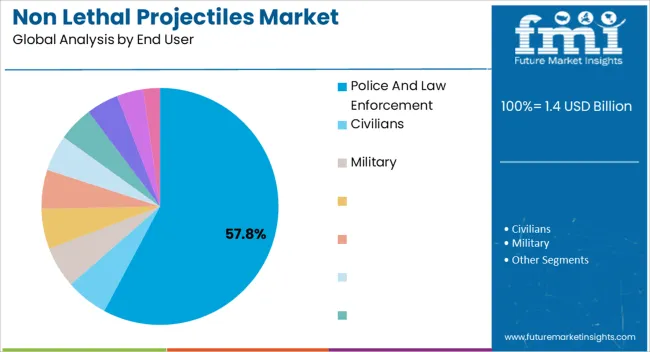
The police and law enforcement end user segment is expected to hold 57.80% of Non Lethal Projectiles market revenue in 2025, representing the largest consumer group. This dominance is being driven by the sector’s critical need for tools that enable crowd control, public order management, and suspect subdual without causing fatalities. The segment’s growth has been reinforced by increasing regulatory emphasis on humane law enforcement and accountability in policing operations.
Agencies are increasingly adopting non lethal projectiles to enhance officer safety, reduce liability, and comply with standards governing the use of force. Rising public expectations for ethical policing practices, along with expanding deployment in urban centers and high-risk areas, have strengthened the adoption of non lethal solutions.
The ability to integrate projectiles into existing enforcement protocols, combined with operator training programs and tactical adaptability, has further supported the segment’s market share As law enforcement agencies continue to modernize their operational capabilities, this segment is expected to remain the primary driver of market demand.
Non Lethal Projectiles are a key component of weapons that are used to incapacitate a person without causing death or permanent injury. In emergency situations where force in required to be used, Non Lethal Projectiles fired from special guns or deployed by human force inflict pain on impact with targets. Non Lethal Projectiles inflict enough pain or have enough impact on the human targets so as to temporarily incapacitate them, or restrain them from fleeing and or retaliating. Non Lethal Projectiles use different mechanisms to inflict pain or restrain people, depending on product types. Non Lethal Projectiles such as rubber or plastic bullets or pellets cause high physical impact on targets, which may also cause physical injuries of a temporary nature.
Non Lethal Projectiles such as tear gas canisters use a chemical mechanism to cause visual disruption, pain and cognitive confusion among a target group of humans to disorient them. Some types of Non Lethal Projectiles use a mechanism that deliver electrical shocks to targets, thus rendering them temporarily immobile or in a reduced state of mobility. Thus Non Lethal Projectiles are highly useful in handling volatile situations and save lives on both sides, the user as well as the target.
Considering these aspects of the Non Lethal Projectiles, the study of the trends and forecasts of the Non Lethal Projectiles market becomes an important read.
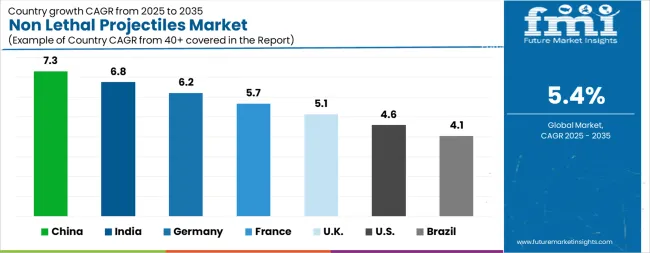
| Country | CAGR |
|---|---|
| China | 7.3% |
| India | 6.8% |
| Germany | 6.2% |
| France | 5.7% |
| UK | 5.1% |
| USA | 4.6% |
| Brazil | 4.1% |
The Non Lethal Projectiles Market is expected to register a CAGR of 5.4% during the forecast period, exhibiting varied country level momentum. China leads with the highest CAGR of 7.3%, followed by India at 6.8%. Developed markets such as Germany, France, and the UK continue to expand steadily, while the USA is likely to grow at consistent rates. Brazil posts the lowest CAGR at 4.1%, yet still underscores a broadly positive trajectory for the global Non Lethal Projectiles Market. In 2024, Germany held a dominant revenue in the Western Europe market and is expected to grow with a CAGR of 6.2%. The USA Non Lethal Projectiles Market is estimated to be valued at USD 530.8 million in 2025 and is anticipated to reach a valuation of USD 831.4 million by 2035. Sales are projected to rise at a CAGR of 4.6% over the forecast period between 2025 and 2035. While Japan and South Korea markets are estimated to be valued at USD 78.2 million and USD 37.7 million respectively in 2025.
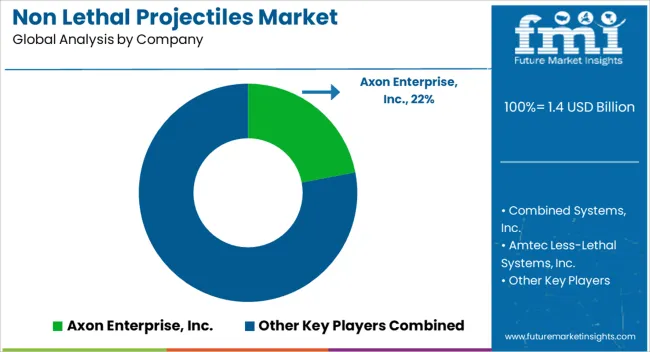
| Item | Value |
|---|---|
| Quantitative Units | USD 1.4 Billion |
| Product Type | Rubber, Bean Bag Rounds, Bullets, Plastic, Wooden, Pellets, Sponge Grenades, Gas & Spray Rounds, and Electroshock Weapons |
| Impact Type | Kinetic And Physical, Chemical, and Electromagnetic |
| End User | Police And Law Enforcement, Civilians, and Military |
| Regions Covered | North America, Europe, Asia-Pacific, Latin America, Middle East & Africa |
| Country Covered | United States, Canada, Germany, France, United Kingdom, China, Japan, India, Brazil, South Africa |
| Key Companies Profiled | Axon Enterprise, Inc., Combined Systems, Inc., Amtec Less-Lethal Systems, Inc., Nonlethal Technologies, Inc., Lamperd Less Lethal, Inc., United Tactical Systems, LLC, Condor Non-Lethal Technologies, and Rheinmetall AG |
The global non lethal projectiles market is estimated to be valued at USD 1.4 billion in 2025.
The market size for the non lethal projectiles market is projected to reach USD 2.4 billion by 2035.
The non lethal projectiles market is expected to grow at a 5.4% CAGR between 2025 and 2035.
The key product types in non lethal projectiles market are rubber, bean bag rounds, bullets, plastic, wooden, pellets, sponge grenades, gas & spray rounds and electroshock weapons.
In terms of impact type, kinetic and physical segment to command 51.3% share in the non lethal projectiles market in 2025.






Full Research Suite comprises of:
Market outlook & trends analysis
Interviews & case studies
Strategic recommendations
Vendor profiles & capabilities analysis
5-year forecasts
8 regions and 60+ country-level data splits
Market segment data splits
12 months of continuous data updates
DELIVERED AS:
PDF EXCEL ONLINE
Nonwoven Fabrics Market Size and Share Forecast Outlook 2025 to 2035
Non-Motorized Ring Main Unit Market Size and Share Forecast Outlook 2025 to 2035
Non Destructive Testers (NDT) Equipment Market Size and Share Forecast Outlook 2025 to 2035
Nonaisoprenol Market Size and Share Forecast Outlook 2025 to 2035
Nonmetallic Mineral Product Market Size and Share Forecast Outlook 2025 to 2035
Non-Magnetic Connectors Market Size and Share Forecast Outlook 2025 to 2035
Non-Selective Broadleaf Herbicides Market Size and Share Forecast Outlook 2025 to 2035
Non-Insulin Peptide Drugs Market Analysis - Size, Share, and Forecast Outlook 2025 to 2035
Non-Invasive Blood Glucose Monitoring Devices Market Size and Share Forecast Outlook 2025 to 2035
Nonylphenol Ethoxylates Market Size and Share Forecast Outlook 2025 to 2035
Non-Invasive Blood Pressure Analyzer Market Size and Share Forecast Outlook 2025 to 2035
Non-Contrast CT Imaging Market Size and Share Forecast Outlook 2025 to 2035
Nonwoven Filter Media Market Size and Share Forecast Outlook 2025 to 2035
Non-fat Dry Milk Market Size and Share Forecast Outlook 2025 to 2035
Non-Powered Air Purifying Respirator Market Size and Share Forecast Outlook 2025 to 2035
Non-Cryogenic Air Separation Unit Market Size and Share Forecast Outlook 2025 to 2035
Non-Sterile Liquids Suspensions Market Size and Share Forecast Outlook 2025 to 2035
Non-Polarized Electric Capacitor Market Size and Share Forecast Outlook 2025 to 2035
Non-Dairy Yogurt Market Analysis - Size, Share, and Forecast Outlook 2025 to 2035
Non-Dairy Ice Cream Market Size and Share Forecast Outlook 2025 to 2035

Thank you!
You will receive an email from our Business Development Manager. Please be sure to check your SPAM/JUNK folder too.
Chat With
MaRIA